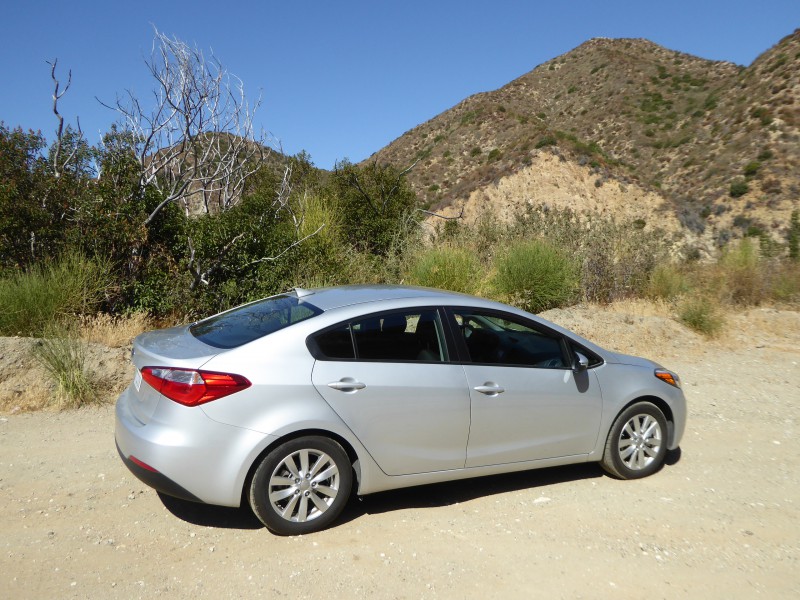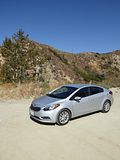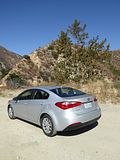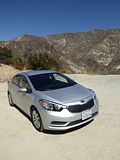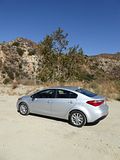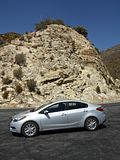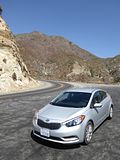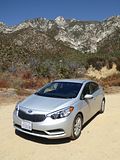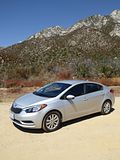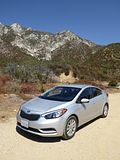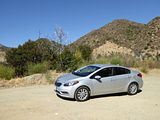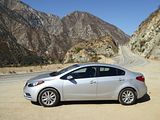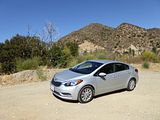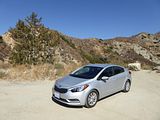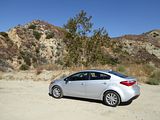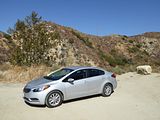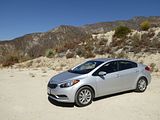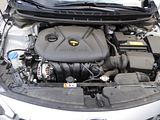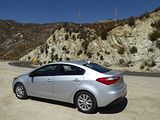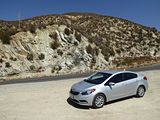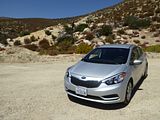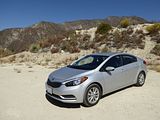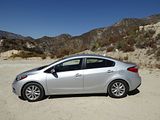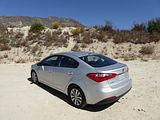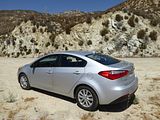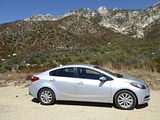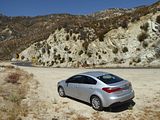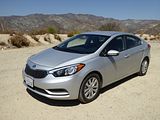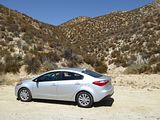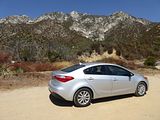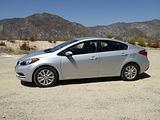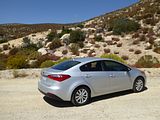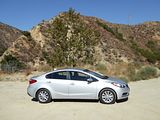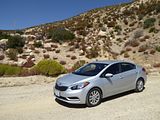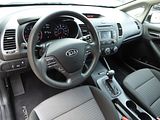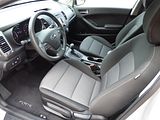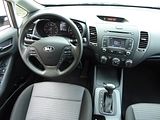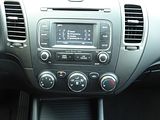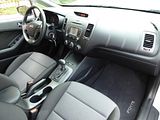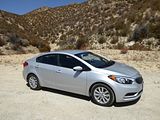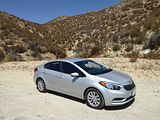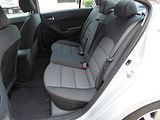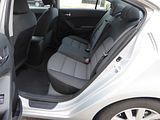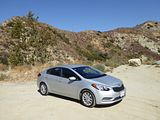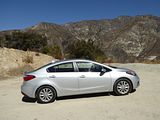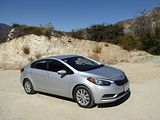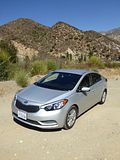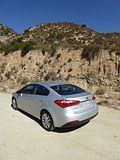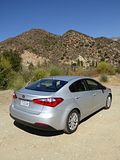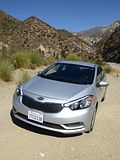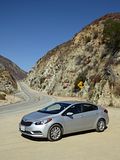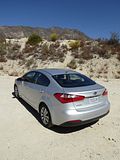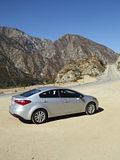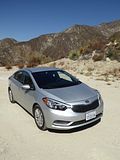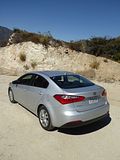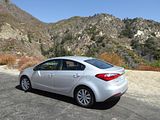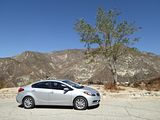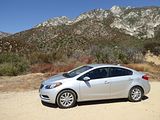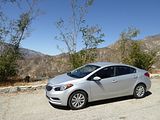

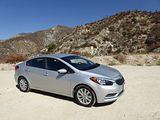
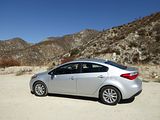
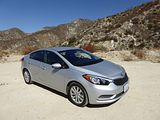
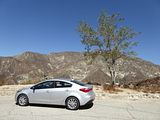
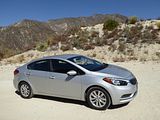
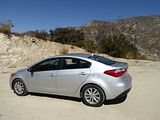

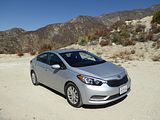
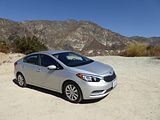

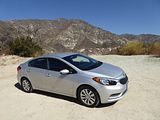
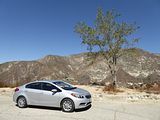
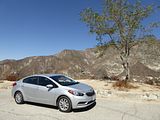

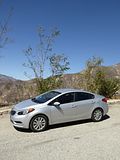
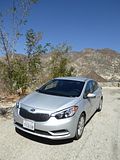
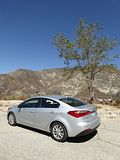
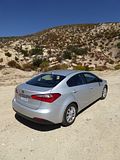

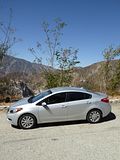

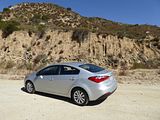
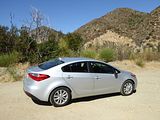
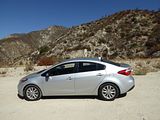
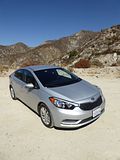
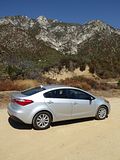
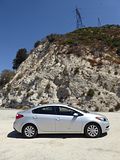
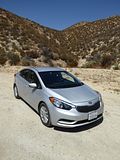
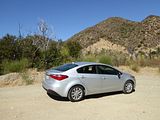
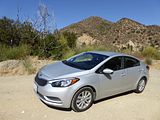
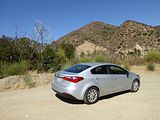
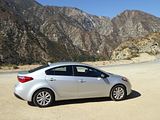

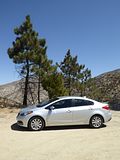
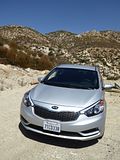
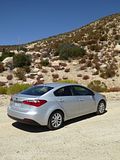
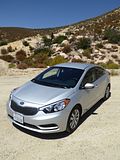
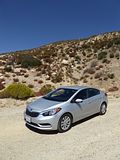
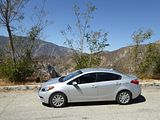
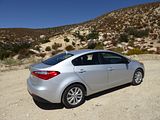

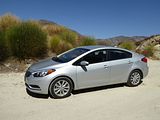
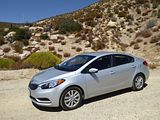
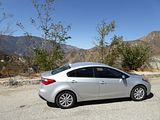
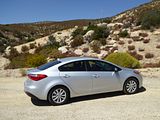

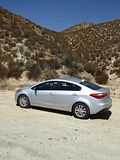
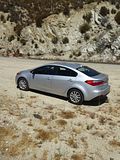
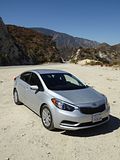
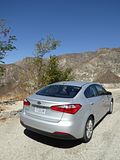
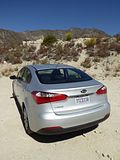
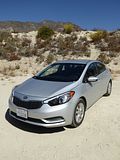
This second generation Forte sticks pretty closely to the format of the first. It is, by the standards of the class, a very conventional car. However, it underwent a complete redesign, which resulted in a car which is slightly larger in every dimension than its predecessor, with new engines, swoopier styling incorporating LED head and taillights, and a completely revised interior making more use of higher quality materials. There is nothing particularly surprising about the design, as cars in this class which stray far from class norms tend not be appreciated by the buying public.
There are three different engines available in the Forte. Standard in the Sedan, and fitted to the test car was a 1.8 litre 145 bhp 4 cylinder unit, called the Nu (the Greek letter), it was new for this model and smaller than what was offered in the previous generation, and slightly less powerful with it. A six speed manual transmission is standard, but the test car had the optional six speed automatic box. There is an organ pedal style accelerator, and I found you needed to give it a fairly firm prod to kick the Kia into action, but once underway, acceleration was respectable, though far from brisk. If you want more power, you would need to stump up for the 173 bhp 2 litre version of the Nu engine which comes as standard in the Koup and the Hatch or go the whole hog and select the top model 201 bhp 1.6 Turbo. Extra power would I am sure be welcome, but is probably not strictly necessary, as the Forte was more than able to keep with the flow of traffic and was not taxed by the inclines of the canyon roads on which I took it. I understand that you will get the best economy from this version, too. I only managed to squeeze 3.15 US gallons into the tank having driven 130 miles, and there was quite a lot of driving a few yards and cutting the engine again, for photography, so the consumption which computes to 41.26 mpg US or 49.3 mpg Imperial, is exceptionally good. Bear in mind that there were few test miles done at rural freeway speeds, so this is probably as good as you are ever likely to see, but even so it still counts as impressive. All Forte models have an electric steering system called FlexSteer, which has three modes, of Normal, Comfort and Sport.
My initial thoughts as I moved away from the Hertz rental facility were that the steering was too light. Not completely feel-less, Toyota style, thankfully, but certainly not going to trouble Ford or Mazda for class honours. However, once I got onto the twistier roads up in the mountains, I came to revise my judgment, as the Forte’s steering was actually quite well judged for driving on these roads, with plenty of feedback from the wheel, and a fluency from the suspension which meant that it could tackle the sweeping bends with ease. There is ultimately some understeer, but you had to be going almost too quickly for the bend for this to become evident. The test car was fitted with 205/55 R16 wheels, and these helped to give it a comfortable ride. Couple that with low noise levels – something of an improvement on the old car, which was a bit too vocal when underway – and this is quite a civilised small family saloon. It is an easy one to drive, too, with good brakes, including a traditional pull-up handbrake fitted between the seats, and it is easy to see out of. A reversing camera was fitted, which projected a clear image of what was behind the car onto the audio unit display screen.
The inside of the Forte was very black. The upholstery was a black cloth, and the dash and door casings were all black, with just a few chrome highlights around some of the knobs on the centre of the dashboard to provide some relief. The plastics were of a pleasing texture but felt rather hard to the touch, but everything fitted together nicely, and there is a cohesive and simple unfussy design to the cabin. The instruments are grouped under a single curved binnacle. There are two large dials, for speedometer and rev counter, with smaller gauges inset in the lower portion of these for fuel level and water temperature. Between the dials is a trip computer display area, which had a rather limited array of things to show you. The centre of the dash contains a small touch sensitive display screen for the audio unit, which I was pleased to discover did include XM Satellite radio even in this entry level car. Below this unit are three rotary dials for the air conditioning. Granted it was hot on the day of the test, but until I had the fan on the third of four speeds, there seemed to be precious little cold air coming into the cabin. The higher speeds were effective, but clearly noisier. Twin column stalks operate the indicators and lights on the left and wipers on the right. Buttons on the steering wheel boss are audio unit repeaters and for the cruise control. The wheel itself was a plastic moulding. That was about it. Simple, intuitive and easy to use, unlike a couple of the Kia’s rivals.
An entry level car this may have been, but it was still easy to get comfortable. All adjustments of the seat and column are of course manual, but with the wheel going up/down as well as in/out and a height adjuster on the seat, it was easy to get my ideal driving position, and the seat itself, trimmed in a tough feeling cloth, seemed very supportive, though I did not spend hours on it uninterrupted as is sometimes the case with test cars. Rear seat passengers should be happy enough, too. Despite the slightly sloping roofline, there was still ample head room, and even with the front seats well back, leg room was still quite acceptable. There is a drop down armrest, with twin cupholders in its upper surface, but should there be a need for three adults to occupy the seat instead, then I suspect they would fit, if a little tightly, as the Forte is simply not that wide. The boot is a reasonable size. It is a nice regular shape, and it extends well back to the rear seats, the backrests of which can be folded down for greater luggage length. There is some space for odds and ends under the boot floor, around the spare wheel. Inside the cabin, there is a good sized glovebox, there are narrow but long bins on all four doors, with mouldings to accept a bottle, a rather small cubby under the central armrest and another surprisingly deep lidded cubby area in front of the gearlever. There was only one map pocket on the back of the front passenger seat.
The base Forte LX, like the test car, starts at $15,990, which makes it one of the cheapest cars in its class. Standard spec is the 1.8-litre four-cylinder engine and manual transmission. You can substitute an automatic transmission for $1,710. The LX’s standard features will keep you entertained on your drive. They include Bluetooth connectivity, satellite radio, and a four speaker sound system with auxiliary and USB inputs. You can add the LX Popular Plus Package, which had clearly been fitted to the test car, as this brings the rear-view camera and touch-screen audio display. The EX gets a slightly bigger 2.0-litre four-cylinder engine and starts at $19,990, while offering more amenities and available packages. With this trim, you’ll enjoy a 4.3-inch touch-screen audio display, a rearview camera, and cruise control. For $3,000, the EX Premium Package includes a power sunroof, navigation with voice commands, Kia’s UVO infotainment system, push-button ignition, leather seats, and heated front seats. Another $2,000 on top of the Premium Package gets you the EX Premium Plus Package that includes a power-adjustable and ventilated driver’s seat, heated rear seats and steering wheel, and dual-zone automatic climate control. If four doors aren’t enough, the Forte5 hatchback adds a hatch to increase the Forte’s versatility. The Forte5 LX starts at $18,090 and features the 2.0-litre engine with manual transmission. Standard features are the same as the sedan LX trim, but the hatchback model allows you to add the LX Popular Plus Package for $1,310, which brings the rearview camera and touch-screen audio display. The EX trim costs $20,390 with the same 2.0-litre engine and features as the sedan EX. Max out the EX with the $4,500 Premium Technology Package, which includes a power sunroof, the UVO infotainment system, voice-command navigation, push-button start, dual-zone automatic climate control, leather seats, heated front and rear seats, and a heated steering wheel. For $20,990, the Forte5 SX boasts a standard six-speaker sound system, a touch-screen audio display, a rearview camera, push-button start, and a peppy turbocharged 1.6-litre engine with manual transmission. You can swap in an automatic gearbox for only $1,000. The SX Premium Tech Package ($4,200) bolsters the added performance with comfort and convenience, offering the power sunroof, the UVO infotainment system and navigation, leather seats, heated front and rear seats, a heated steering wheel, a ventilated driver’s seat, and dual-zone automatic climate control. The two-door Forte Koup offers many of the same features as its more prosaic brethren in a more stylish package. The EX trim retails for $19,890 and comes with the 2.0-litre engine and six-speaker sound system with standard touch-screen display and a rearview camera. The EX Premium Tech Package costs $4,500 and buys you a power sunroof, push-button start, voice-command navigation and UVO services, leather seats, heated front seats and steering wheel, a ventilated driver’s seat, and dual-zone automatic climate control. The Koup SX is available for $20,690 and features the 1.6-litre turbocharged engine with manual transmission and push-button start, though an automatic can be optioned for $1,000. The SX includes the same standard features as the EX Koup, along with the UVO infotainment system standard. Leather seating and the navigation interface are optional as well.
Although this is far from an exciting car, buyers in this class, especially those selecting the lesser trim levels and entry level engines, are more interested in something that is easy to drive, dependable, well put together, roomy enough, nicely finished, ideally that looks good and which will be painless to own. The Forte is all those things. Unlike most of its rivals, it has no significant weak spot whereas the Nissan Sentra is noisy, the Corolla is, well, a Corolla, which means anodyne and with feel-less steering, the Focus has a messy interior and a god-awful automatic gearbox, the Dart feels underpowered and the Lancer is just pre-historic, So of the cars against which the launch Forte models were compared at the end of 2012, it is easy to see why it swept the board. However, since then some new models have arrived, notably the very bland looking Chevrolet Cruze, Honda’s anything but bland (OK, hideous, if you want my honest opinion!) Civic, and not quite so recently, the good looking Mazda 3, as well as a slightly less stylised new Hyundai Elantra. Can the Forte beat all of those? I suspect not, as all four have been praised highly for setting new standards in this family car class. I now need to try to source an example of each to find out which is the current class champ, but in the meantime can assert that the Forte is a competent and likeable small family saloon.

